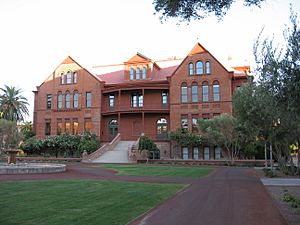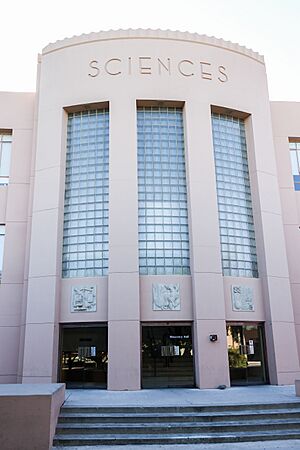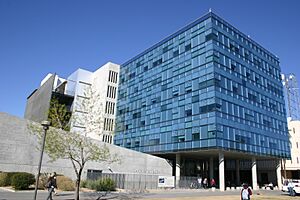History of Arizona State University facts for kids
The history of Arizona State University began on March 12, 1885. This is when the school was first created. It was originally called the Territorial Normal School at Tempe. A lawmaker named John Samuel Armstrong suggested a bill to start a "Normal School" in Arizona. A normal school was a place to train teachers.
The school officially opened on February 8, 1886. Hiram Bradford Farmer was the first principal. Local residents George and Martha Wilson gave land for the school. At first, 33 students met in just one room.
Contents
Starting the School
Arizona State University began in 1885. It was called the Territorial Normal School at Tempe. This happened because of a law passed by the Arizona Territory's government.
Many people in Arizona wanted a school to train teachers. But it wasn't until 1885 that lawmakers decided to act. They were also thinking about building a mental health facility and a university. Different towns wanted these new buildings.
John Armstrong was a young lawmaker from Maricopa County. He wanted to bring the mental health facility and the university to his area. He became the head of the House Education Committee.
Armstrong saw a chance to bring the normal school to Tempe. He worked with other lawmakers. They agreed to support his idea for the normal school. In return, he supported putting the mental health facility in Phoenix and the university in Tucson.
On February 26, 1885, Armstrong introduced his bill. It was called “An Act to Establish a Normal School in the Territory of Arizona.” The bill said the school would train public school teachers. It would also teach about farming and mechanical skills. The bill asked for $5,000 to start the school. It also set aside $3,500 for two years of running costs. The people of Tempe had to donate land for the school within 60 days.
The bill passed quickly in the House. Then, on March 11, the Council also passed it. This meant the normal school would be built in Tempe, Arizona. The next day, Governor F.A. Tritle signed the bill into law. He also signed the bill to create the university in Tucson.
The last step was getting 20 acres of land in Tempe. George and Martha Wilson owned a cow pasture. They agreed to donate their entire 20-acre pasture for $500. This land became the main part of the school's campus.
Early Years of Growth
Principal Hiram Bradford Farmer opened the school on February 8, 1886. It was the first higher education school in Arizona. The Normal School was meant to teach people, both boys and girls, how to be good teachers. It also taught general school subjects, mechanical skills, farming, and the laws of the United States.
To get in, students had to be at least 16 years old. They also had to pass an entrance test. Principal Farmer taught all the subjects himself at first. If students didn't have a high school diploma, they could take "sub-normal" classes until 1923. After finishing the program, students received a diploma and a teaching certificate.
By 1899, students needed to complete a three-year course to get a diploma. By 1900, the school had six teachers and 131 students.
In 1901, the school's official name became Tempe Normal School. This was because another normal school opened in Flagstaff, Arizona. The school started offering classes in manual arts in 1906 and agriculture in 1912. These subjects were part of the original plan for the school.
On March 20, 1911, President Theodore Roosevelt visited Tempe Normal School. He gave a speech to the community from the steps of Old Main. He talked about his ideas for educating children and developing the area.
In the 1920s, the school worked to become a stronger teachers' college. In 1923, students needed a high school diploma to get in. By 1925, the school was called Tempe State Teachers College. It had 41 teachers and 672 students. By 1929, it offered a four-year program. Students could earn a Bachelor of Education degree. This degree allowed them to teach in high schools.
Becoming a University
In the early 1930s, the school needed to be officially recognized as a quality educational institution. This is called accreditation. To get accredited, many teachers needed to have advanced degrees. So, under President Ralph Swetman, new teachers with higher degrees were hired.
In 1933, Grady Gammage became President. Later that year, the school received its first full accreditation. In 1937, it offered its first graduate degree, a Master's in Education. Even though it offered other subjects, it was still mainly a teachers' college until 1945.
In 1945, the school dropped "teacher's college" from its name. It became Arizona State College at Tempe. It offered more types of classes. After World War II, many soldiers returned to the area. They used their GI Bill money to go to college. As a result, the school's enrollment grew a lot. It went from 4,094 students in 1949.
In 1953, the school was evaluated. A report in 1954 said that Arizona State College was "rapidly becoming a university." It suggested creating four different colleges within the school. This idea caused some debate. But the governor voted to accept the recommendations.
Many people argued about whether Arizona needed a second university. Students at Arizona State College gathered signatures to support becoming a university. The local newspaper, the Arizona Republic, started calling it Arizona State University.
In March 1958, a lawmaker suggested naming the school Tempe University. Hundreds of angry students protested at the Arizona State Capitol. The lawmaker promised to withdraw his bill. President Gammage then quietly started a plan to let the people of Arizona vote on the name change.
Students, alumni, and community members worked hard. They collected over 63,000 signatures to get the issue on the ballot. People who didn't want the name change argued that it was a waste of money. But supporters traveled the state to promote Arizona State University.
On November 4, 1958, election day arrived. Thousands of student volunteers helped voters. The results showed that Proposition 200, which would change the name, was approved by a two-to-one margin. Celebrations broke out! On December 5, 1958, the governor signed the order. This officially created Arizona State University.
Becoming a university by name was a big step. But the school still needed more talented teachers, graduate students, and labs. These were needed to become a true research university.
Becoming a Research University
After becoming a university, ASU worked hard to become a place where important research happens. A "research university" means it does a lot of new scientific studies and discoveries.
In the 1940s, Dr. Herbert Stahnke did research on scorpions and snakes. He even created anti-venom. This work helped start the Poisonous Animals Research Laboratory in 1945. His research was so important that he got support from national science groups.
Later, H. H. Nininger, a meteorite expert, wanted to work with ASU. In 1960, ASU bought his huge collection of meteorites. This collection is one of the biggest in the world. It got the attention of important science groups like the National Science Foundation and NASA.
Soon after, Dr. Carleton Moore became the first director of ASU's Center for Meteorite Studies. He received many research grants. Dr. Moore was even chosen to study Moon rocks brought back by NASA's Apollo missions in the 1970s. His work helped ASU become known for planetary geology and astrophysics research.
The university also needed labs for scientific research. The College of Engineering worked with companies like General Electric and Motorola. This helped them buy expensive equipment. Early labs focused on things like fluid mechanics and engine development. This research helped Arizona businesses create new technologies.
In 1960, President G. Homer Durham arrived at ASU. He worked to hire more research scientists. Top researchers like Carleton Moore joined ASU. These new teachers helped build the labs and programs needed to attract more talented researchers. This led to many students earning science PhDs.
President Durham also helped expand ASU's classes. He created new colleges like the College of Fine Arts, the College of Law, and the College of Nursing.
Growing Bigger
The next presidents, Harry K. Newburn, John W. Schwada, J. Russell Nelson, and Richard Peck, helped the university grow even more. They improved its academic standing as more and more students wanted to attend.
In 1984, Phoenix was growing very fast. So, ASU opened the West Campus. This campus was first meant for students who had finished two years at a community college. But as more students wanted to attend, it became a four-year program.
From 1990 to 2002, Dr. Lattie F. Coor was president. Under his leadership, ASU grew to have multiple campuses. He started the ASU East campus (now the Polytechnic campus). He also created the ASU Downtown Center. Dr. Coor focused on four main goals: diversity, good undergraduate education, research, and helping the economy.
In 1994, ASU was given "Research 1" status. This means it was recognized as a top research university. This was a big achievement for a university without a medical school or large agriculture programs. Dr. Coor also led a very successful fundraising campaign. It raised over $300 million from private donations. This money helped create important parts of the university. These include the Barrett Honors College and the Katherine K. Herberger College of Fine Arts.




